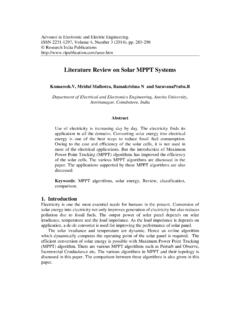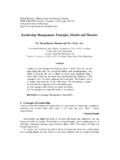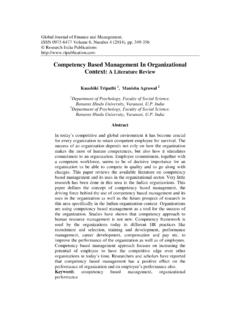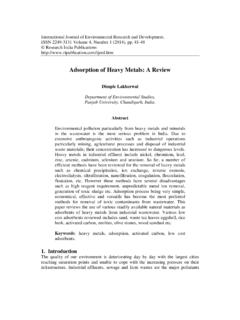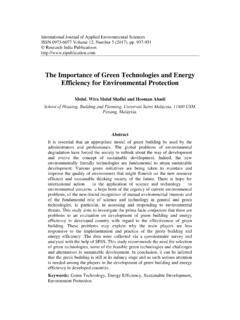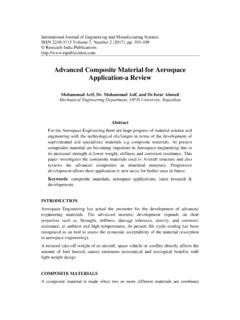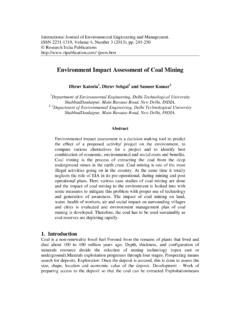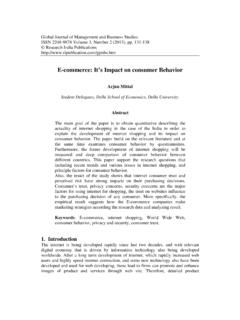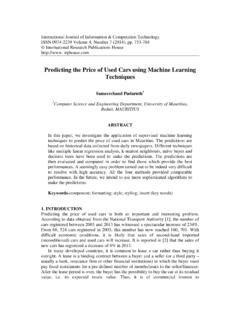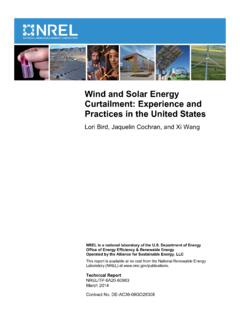Transcription of Solar Powered Smart Irrigation System
1 Advance in Electronic and Electric Engineering. ISSN 2231-1297, Volume 4, Number 4 (2014), pp. 341-346 Research India Publications Solar Powered Smart Irrigation System S. Harishankar1, R. Sathish Kumar2, Sudharsan , U. Vignesh and Department of Electrical and Electronics Engineering, Amrita University Ettimadai, Coimbatore, India Abstract Cost effective Solar power can be the answer for all our energy needs. Solar Powered Smart Irrigation systems are the answer to the Indian farmer. This System consists of Solar Powered water pump along with an automatic water flow control using a moisture sensor. It is the proposed solution for the present energy crisis for the Indian farmers.
2 This System conserves electricity by reducing the usage of grid power and conserves water by reducing water losses. Keywords: Smart Irrigation ; Solar power; Solar pump; moisture sensor;energy crisis. 1. Introduction Solar energy is the most abundant source of energy in the world. Solar power is not onlyan answer to today s energy crisis but also an environmental friendly form of energy. Photovoltaic generation is an efficient approach for using the Solar energy. Solar panels (an array of photovoltaic cells) are nowadays extensively used for running street lights, for powering water heaters and to meet domestic loads. The cost of Solar panels has been constantly decreasing which encouragesits usage in various sectors.
3 One of the application of this technology is used in Irrigation systems for farming. Solar Powered Irrigation System can be a suitable alternative for farmers in the present state of energy crisis in India. This a green way for energy production which provides free energy once an initial investment is made. In this paper we propose an automatic Irrigation System using Solar power which drives water pumps to pump water from bore well to a tank and the outlet valve of tank is automatically regulated using controller and moisture sensor to control the flow rate of water from the tank to the Irrigation field which optimizes the use of water.
4 The R. Sathish Kumar et al 342paper is divided into 6 sections discussing the literature survey, proposed solution, implementation , cost analysis and results and conclusion, references. 2. Literature Survey and Background Study According to the survey conducted by the Bureau of Electrical Energy in India in 2011 there are around 18 million agricultural pump sets and around million new connections per year is installed with average capacity 5HP. Total annual consumption in agriculture sector is billion KWh (19% of total electricity consumption).As cited in paper [1] Solar Powered Smart Irrigation technique is the future for the farmers and a solution for energy crisis.
5 So for the proposed Solar Powered System we are using techniques analyzed in paper [2] and [4] and modified. Sine PWM technique has been used for inverter operation for minimum harmonics as given in paper [3] which further increases the efficiency of the rating of the System was calculated corresponding to the pump specifications referring to paper [5]. 3. The Proposed Solution In this proposed System we utilize the Solar energy from Solar panels to automatically pump water from bore well directly into a ground level storage tank depending on the intensity of sunlight. While conventional methods include pumping of water from bore well into a well and from this well onto field using another pump, our System uses only a single stage energy consumption wherein the water is pumped into a ground level tank from which a simple valve mechanism controls the flow of water into the field.
6 This saves substantial amount of energy and efficient use of renewable energy. A valve is controlled using intelligent algorithm in which it regulates the flow of water into the field depending upon the moisture requirement of the land. In this System we use a soil moisture sensor that detects the amount of moisturepresent in the soil and depending upon the requirement of level of moisture content required for the crop the water flow is regulated thus, conserving the water by avoiding over flooding of crops. System description Proposed Irrigation System mainly consists of two modules- Solar pumping module and automatic Irrigation module. In Solar pumping module a Solar panel of required specification is mounted near the pump set.
7 Fig. 1: Block diagram of Solar pumping module. Solar Powered Smart Irrigation System 343 Then using a control circuit it is used to charge a battery. From the battery using a converter circuit it gives power to the water pump which is submerged inside the well. Then the water is pumped into an overhead tank for storing water temporarily before releasing the water into the field. In automatic Irrigation module the water outlet valve of the tank is electronically controlled by a soil moisture sensing circuit. The sensor is placed in the field where the crop is being cultivated. The sensor converts the moisture content in the soil into equivalent voltage.
8 This is given to a sensing circuit which has a reference voltage that can be adjusted by the farmer for setting different moisture levels for different crops. The amount of water needed for soil is proportional to the difference of these two voltages. A control signal was given to a stepper motor whose rotational angle is proportional to the difference in voltage. The stepper motor in turns controls the cross-sectional area of the valve to be opened controlling flow of water. Therefore the amount of water flowing is proportional to the moisture difference. Fig. 2: Block diagram of automatic Irrigation module. 4. implementation For the implementation of the proposed System we are using a 2 HP water pump and various modules which are designed and fabricated separately and then finally they are assembled together to implement the proposed System .
9 Solar energy is harnessed using Solar panel PVL-68 that generates 53W at Nominal Operating Cell Temperature. It is 24V, amorphous silicon type Solar cell. Specification of the Solar panel selected: Array capacity --240Wp Irradiance 580 W/m2 Open circuit voltage V Short circuit current A Load test on a Solar panel have been conducted and its maximum and minimum values is tabulated. Table 1: Load test characteristics of Solar panel. S. No Voltage ( in Volts) Current (in Ampere) Irradiance ( W/m2) 1 300 2 710 R. Sathish Kumar et al Design of converter and battery specification An inverter is designed with a DC input of 230V which is generated from 12V using a boost converter.
10 Sine PWM technique is applied to generate 230V The inverter circuit fabricated is shown in Fig. 4. As far as battery is concerned we are using a battery with 12V, 100Ah capacity for a 2HP pump. Moisture sensor module A moisture sensor is used to sense the level of moisture content present in the Irrigation field. It has a level detection module in which we can set a reference value. This circuit can be used with analog probes that produce a voltage proportional to soil moisture such as VG400 probe shown in Fig. 3. The moisture content of the soil is found by using the soil moisture sensor such as VG400 which produces an equivalent output voltage proportional to the conductivity between the two probes.
